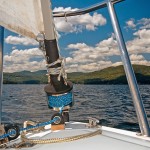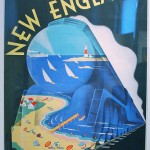What You Need To Know About The Vacation Home Market: A Realtor’s Perspective

Amanda Loder / StateImpact/NHPR
Long-time Moultonborough Realtor Jim Mardis sums up the state of the second home market for StateImpact
StateImpact has been on the road this week, as part of our month-long series on the state’s vacation home economy. We headed to the mother of all New Hampshire tourism communities: the town of Moultonborough, along Lake Winnipesaukee. You may remember from our previous coverage that 61 percent of the homes in the area are second homes. Although it’s not the most heavily-saturated tourist town, Moultonborough does claim the highest raw numbers for vacation homes: 2,991.
As part of our Lakes Region meanderings, StateImpact popped by the Moultonborough office of Realtor Jim Mardis. He’s President of Century 21 Lakes Region Realty. Mardis has 34 years of experience selling primary and second homes in the area. And he does a booming business in the area, employing 22 agents. So we decided to find out what the town’s post-recessionary housing market looks like, from the realtor’s perspective.
Q: How would you describe the difference in pricing between the second home that you would buy along the lake versus just moving into town and buying…a [primary] house in Moultonborough?
A: That’s a loaded question. There’s a very wide range in pricing. If you’re looking to purchase…I would say $200,000 for the residential markets might be a good average for the Moultonborough-Meredith area. Water access would be a subdivision that would be…beside a lake, either on the big lake, Winnipesaukee, or a smaller lake. There would be a…shared beach, and you would have homes that would have deeded rights to those beaches. Because it’s shared frontage, those prices are…more affordable. And you can get four season homes on nice lots starting, even in the water access market, $175,000 to $225,000, on up to $300,000, $350,000.
When you get into the waterfront market, there’s a huge variation…Does it have a 20 mile view, or does it have a view looking across a very, very narrow bay? Typically the longer the view, the better the view. Whether there’s a sand beach or not a sand beach. Sand beaches are preferred. They’re not typical on the lake, so they’re rather unique. So a parcel that might have a sand beach, that might have a long view, that might have a southerly exposure…those tend to gather a higher sum as well. And there’s some parcels of land where the raw value of the land might be a million dollars.
Q: Given the housing crash, how, if at all, have your sales of these second homes…been affected?
A: There’s no doubt that we’ve been affected by this. I’ve seen a couple of these before. This one seems to have longer legs than the previous ones. And about one thing that I’ve noticed, and I think it’s unique about this market, and probably some other second home markets as well, is there seems to be a resilience on the part of owners, whereby they’ve held their prices.

Amanda Loder / StateImpact/NHPR
There are big variations in housing costs across the Lakes Region. A lot of that diversity arises from proximity to water and (of course) the view
Prices have come down, but we don’t see the level of foreclosures that you’d see in primary markets in Florida, in the Southwest. Prices, I think, are still coming down slightly…It’s very, very difficult to say what our national economy’s going to do. But I do think, though, that we see a big difference in the way people view investments here in the Lakes Region. Back in the mid-‘80’s, for example, we had a lot of people purchasing strictly for the investment value. Well, for two reasons. They would buy because they thought it was a tremendous investment that they could quickly turn around the property, sell the property, make a profit on the property very, very quickly. They would also buy it because there would be the personal use and enjoyment factor involved. But a lot of people that are buying now are buying because there’s the opportunity to enjoy this lifestyle with their family.
Q: Where have you seen…the biggest difficulties in making sales?
A: Mostly, it’s been in the primary markets. The residential markets. Those homes seem to have been more affected. That is, they stay on the market for a longer period of time. They have been forced to higher levels of price reductions. But interestingly, this year, in particular, the upper end, at least for the first six months, really went well. We saw a number of sales in the $2, 3 and 4 million range. So the upper-end markets seem to be quite strong, actually.
I think that…we’ll find that the next couple years will be more of a stabilizing period than anything else, is my expectation. I don’t think you’re going to see anything shoot back up in a hurry, but I think people are looking for stabilization, because this is…the economy is kind of like a freight train, where it takes awhile for it to slow down, and you know, some people don’t see it coming, because it’s just slowing gradually. And you know, as we’re sitting here today, we don’t know if that has stopped yet. We think, we think that we’re stabilizing, or about to stabilize. But once it returns, it doesn’t speed right up again. It’s so large, the economy’s so large, so it’s going to take awhile for it to regain momentum again. And I think, provided the interest rates stay where they’re at, I think stabilization will last, will come.
Q: If you were to take an average month in ’06 [before the housing market collapse]…how many of these types of homes could you move, versus now? What would that look like in terms of raw numbers?
A: At its peak, and I would say…in 2009, our business was off by nearly 60%. It was dramatic

Amanda Loder / StateImpact/NHPR
Like real estate agencies across the country, Mardis' firm has been finding its footing since the housing market collapsed
drop over what the peak was in the mid-2000’s. And we had a lot of adjustments we had to make in the way we did business. In 2008 and 2009, we lost money…And we hadn’t lost money at this company since the early ‘80s. We returned to profitability in 2010, and we are projecting it again this year. The reasons for that are two-fold. One, business has been getting better in 2010 and 2011, but that combined with the cost-cutting and the revised way that we’re doing business, all of those things come together and are making the picture look better.
Q: As you’re looking forward, are there any emerging trends that you’re seeing in this particular market?
A: Well, I don’t see emerging trends. One thing that is notable is that the spec builders, the number of spec homes that we have on the market right now, is slowly decreasing. So that inventory is working off. Some of that has to do with the fact that some of the spec builders have not reentered the market yet. So the existing inventory that had been built, as it is worked off, we’re starting to see just a couple of the spec builders step back in. Which is kind of interesting, because for years, there had always…[on] this particular side of the lake…been about six or seven spec builders that have been very active in the construction of new homes, mostly on the waterfront. And right now, I think there’s one or two that are active. And those that are active are holding less inventory. So they’re being very selective about what they buy. But nonetheless, they’re successful. There’s one builder that we’re working with now that purchased a lot not too long ago, built a home, and we actually sold it before it was finished. And this builder is now looking for additional inventory. So it’s that kind of momentum that’s good to see, because the demand, you know, success breeds success.
Q: It sounds like, in the run-up to the housing collapse, a lot of what you were dealing with were new homes, new construction. And…now it seems like, with the main construction guys [bowing] out, it’s more turnover?

Amanda Loder / StateImpact/NHPR
As the second home market has slowed down, spec builders are less willing to add more housing inventory to the Lakes Region's shores
A: It is mostly turnover. Absolutely it is. It’s the end-user, as they’re called. I mean, somebody has to buy these spec homes, and it’s not usually a spec builder buying a spec home. So when you have the spec builders’ inventory, when you have that market not as active as it was, what we’re relying on, and what we are seeing, is the end-user market. That would be the family that intends to purchase, improve the property, perhaps, and stay there for awhile.
Q: Is there anything you’d like to add?
A: One really interesting thing that I’ve observed about the town of Moultonborough, in particular, is that the number of real estate transactions on the lake–in this town–supercede all those of all other [lake] towns combined, in a number of years. Haven’t checked to see what we’ve been doing this year, but it wouldn’t be a surprise if again we find in the town of Moultonborough that the dollar volume transactions of units sold would exceed that…of all the other towns that front on Winnipesaukee combined. And there are a couple of reasons that that occurs, I think. One is that we have one of the lowest tax rates around, and that in large part has to do with the fact that it’s a very real estate rich town. It has 70 miles of frontage on Winnipesaukee, which is very high-valued real estate. So it has a lot of…a lot going for it in that regard.
StateImpact recently put together an interactive map, with analysis, of taxes in tourism towns versus the rest of the state. You can check it out here.

